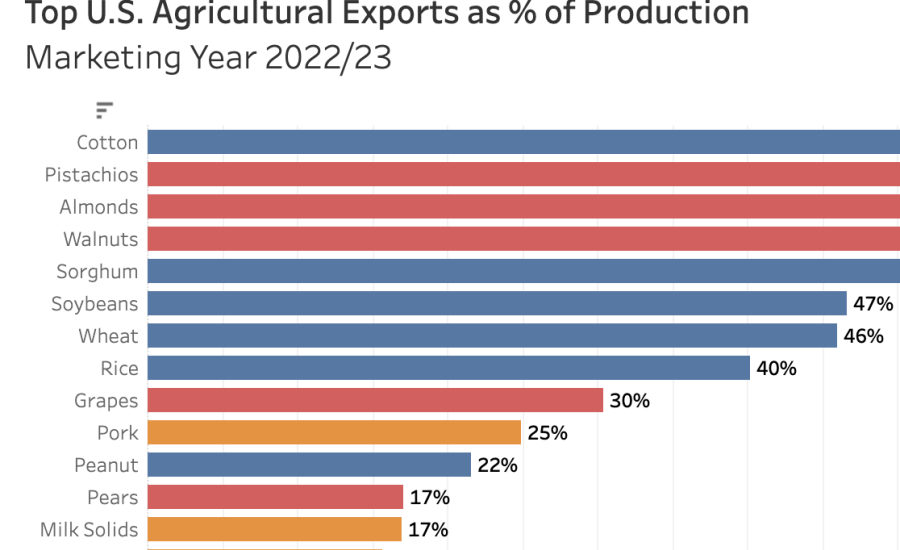Browse Data and Analysis
Filter
Search Data and Analysis
- 13 results found
- (-) Poultry Meat & Prods. (excl. eggs)
- (-) May 2024
- (-) October 2022
- Clear all
U.S. agricultural exports are a critical source of farm income. The USDA Economic Research Service estimates that on average 23 percent of the output of nonmanufactured agricultural products were exported between 2013 and 2022.
Vietnam offers abundant opportunities for exporting consumer-oriented products, despite the challenges of recovering from the COVID-19 pandemic and dealing with high inflation. The Vietnamese economy is poised for significant expansion in the coming decades. With a burgeoning population and a growing middle class, Vietnamese consumers are becoming more discerning about the origin and composition of their food.
The 2023 U.S. Agricultural Export Yearbook provides a statistical summary of U.S. agricultural commodity exports to the world during the 2023 calendar year.
Although extension of anti-dumping duties imposed on frozen bone-in poultry portions from the US would typically mean business as usual as these duties are rebated under the tariff rate quota, a current de-facto restriction on applying general tariff rebates to poultry imported under the TRQ makes the announcement more concerning than usual.
Imports of chicken meat and products in 2023 are forecast to increase to 418,000 metric tons as the UAE’s expanding economy, population, and concomitant building boom fuel higher demand and thus consumption. Transshipments or reexports are playing a growing role in the Arabian Gulf poultry trade and have risen by 74 percent over the last four years.
Russia’s invasion of Ukraine has adversely impacted the global economy, and Egypt too has felt the wave of effects. Russia’s war on Ukraine has relentlessly disrupted international trade of grains and soybeans as well as other commodities pounding a global economy that had since been improving robustly from the COVID-19 pandemic.
Although exports of poultry to the Dominican Republic are on pace to set historic records in 2022, the United States continues to lose export market share from Brazil. As of June, 2022, the United States has accounted for 56 percent (22,074 MT) of total poultry exports to the DR (64,392 MT); Brazil has accounted for 44 percent (17,429 MT) of those exports after only accounting for 25 percent in 2021 and 0 percent in 2020 and prior.
Malaysia again extended the subsidy for the poultry industry until December 2022 to stabilize the price of whole chicken (processed and sold with head, feet, and organs) and eggs, as stated by the Ministry of Agriculture and Food Industries (MAFI) on Sunday, October 9, 2022. In total, Government of Malaysia (GOM) allocations for chicken and egg subsidies from February to December 2022 will amount to RM1.233 billion (USD$265.16 million).
This semi-annual report includes data on U.S. and global trade, production, consumption and stocks, as well as analysis of developments affecting world trade...
In June 2022 the Government of Guatemala confirmed that poultry products exported to Guatemala no longer need the USDA export mark on every box, and instead USDA can apply the mark on every consignment, pallet, or transportation unit. This has resulted in more efficient export clearance times with reduced labor, dock space and loading time which ultimately translates into better poultry prices for consumers.
As the economic environment in Angola has improved, Angolan chicken meat imports also recovered, increasing 57 percent in 2021. Post expects 2022 imports will show slight year-over-year growth as well. In 2021, Angola was the world’s seventh largest importer of U.S. chicken meat by value ($125 million).
Taiwan is the seventh-largest market for U.S. agricultural exports. Taiwan has vibrant urban communities and a highly developed e-commerce industry that provides convenience for customers, all which support Taiwan’s continued demand for safe and high-quality food products. In addition, evolving consumption trends suggest customers are increasingly looking for western-style food options that cannot be locally sourced. Since domestic food production alone cannot match increased food demand, agricultural imports will continue to play an important role in Taiwan’s retail food economy. While trade barriers exist and competition intensifies, opportunities to increase U.S. agricultural exports remain promising.

